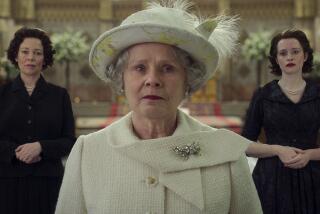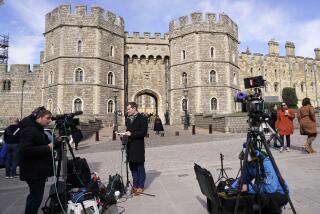Britons Hail Popular Royal and Look Ahead
LONDON — Admirers of Queen Elizabeth the queen mother gathered outside Britain’s royal palaces Sunday to bid goodbye to a beloved symbol of the nation’s imperial history and ponder what her death means for the future of the monarchy.
They brought spring bouquets in the pastel colors favored by the royal matriarch and left condolence notes for Queen Elizabeth II, who has lost her mother and her sister, Princess Margaret, in less than two months.
The Queen Mum was hailed by commoners and aristocrats alike as the mainstay of the royal family and its most popular member. Her death Saturday at 101 deprives the queen of her closest ally and the nation of a unifying royal figure.
“She was a piece of history,” said Lesley Reeves, 43, an East London financial advisor who turned up at Windsor Castle to pay her respects. “We never met her, but somehow she’s always been a part of our lives.”
After a nightlong vigil outside the Windsor gates, Tracey Warner, 19, observed: “She was somebody you could look up to. I don’t think it will be the same now she’s gone.”
Born in 1900, when Queen Victoria reigned and the British Empire encompassed a fifth of the Earth’s landmass and a quarter of its population, the elder Elizabeth served as the last empress of India before the subcontinent was granted independence in 1947. She was an Edwardian aristocrat, scornful of modern royal penny-pinching, who saw the world from the age of radio to the frontier of genetic engineering.
Through it all, she managed to present herself as royal and commoner at once. She was a trout fisherwoman with 50 servants and a people’s queen who couldn’t make ends meet on $1 million a year in state support. Cheered by the sight of her cocked head and perennial smile, Britons loved her.
“Always had a great deal of respect for you, ma’am,” Barry Shaw of Bermondsey, in southeastern London, wrote in a note left outside Clarence House, Elizabeth’s London residence. “You’ve touched a great many people from all walks of life. . . . As we say in south London with greatest respect, R.I.P. Queen Mum.”
Waiting in line to sign a condolence book, Aaron David, 26, of Gateshead, said, “We are definitely poorer for losing her.”
So, said many royal watchers, is the monarchy.
The queen mother’s passing removes a generational buffer between Queen Elizabeth and mortality, and--although healthy and hard-working--the queen will suddenly be perceived as an older 75-year-old. But though her mother’s longevity suggests that the queen could rule for 20 more years or so, the death pushes to the forefront questions about Prince Charles’ suitability to be king, his relationship with the divorced Camilla Parker Bowles, the cost of the royal family and, most important, its constitutional role.
The elder Elizabeth ushered the royal family through the crisis of abdication in 1936, when her husband took the throne as King George VI after his brother, King Edward VIII, abdicated to marry American divorcee Wallis Simpson, and she steered it through divorce scandals involving her grandchildren in the 1990s.
Her death now may bring Queen Elizabeth renewed empathy and support in a year of Golden Jubilee celebrations. But if the queen mother was the most popular royal, will her absence make the royal family less popular?
Her death, the Sunday Times wrote, “comes at a time when, partly thanks to her efforts, the monarchy has entered calmer waters. Public enthusiasm may have waned. . . . But there is now, even for those who do not support the monarchy, a far greater tolerance for its existence. Those who refuse to acknowledge it does much good at least no longer accuse it of doing much harm. Compared with just a few years ago, that is a significant step forward.”
Other political observers, however, suggested that the queen mother left a void that makes a referendum on the future of the monarchy--and the monarch’s role as constitutional head of state--more conceivable.
“For all of the affection with which the Queen Mother was held, she increasingly represented a world, constitutional order and culture that are fading. We are as much nostalgic about what she stood for as grieving,” the Observer said in an editorial Sunday.
“The royal family she built now needs a new lease of creativity if it is still to be venerated as having a key role in Britain’s national life in years ahead.”
The republican paper suggested that the family might best become “no more than a distinguished national family that can nominate its own head without constitutional implications”--patrons of charities, not constitutional heads of state.
But first the country will hold a period of national mourning and a funeral April 9 likely to be reminiscent of its grandest past--the queen mother helped orchestrate it.
Her coffin, now at Windsor, will be taken to London to lie in state before a Westminster Abbey service and burial with her late husband.
The coffin will go first to the Queen’s Chapel at St. James’s Palace, close to Clarence House, where members of the royal family will pay their private tributes. Then it will be taken to Westminster Hall and placed on a purple-draped catafalque where George VI lay in state in February 1952. It will be guarded around the clock by a ceremonial contingent of Yeomen of the Guard.
After the funeral, the coffin will be taken by road to Windsor, where it will be interred in the black marble vault of the George VI Memorial Chapel, specially built at St. George’s Chapel as the final resting place of the king. Princess Margaret’s ashes will be buried with the queen mother.
*
Miller is The Times’ London Bureau chief and Stobart a special correspondent on the bureau staff.
More to Read
Sign up for Essential California
The most important California stories and recommendations in your inbox every morning.
You may occasionally receive promotional content from the Los Angeles Times.










